Ah, someplace a little closer to home for a change. I’ve even been to Bolivia, and I’ve even had the soup we’re going to make in today’s entry for the Bread & Soup Project, quite a few times actually – it’s one of my favorites.  On the bread side, I considered going with something empanada-like – Bolivia has three traditional styles – salteñas, which have a sweet crust, sort of standup like a purse, and are filled with either chicken or beef stew, which you either slurp out, or use a spoon; empanadas, which are a slightly sweet and salty cheese filled turnover, smaller and flatter than empanadas here, and usually eaten aside a cup of coffee in the morning, and tucumanas, which are meat and potato filled empanadas very similar to what we have here in Argentina, and are more or less an afternoon snack, street food. There are also numerous breads that come from various regions of Bolivia, and are quite different one from the other. In the end, though, I went with something “different”, a Sonso (Zonzo), which is sort of like a thick flatbread, or pancake version of a chipa, the classic cheese rolls of southern Bolivia, Paraguay, and northern Argentina. It’s something that’s unique to the country, and a common breakfast bread, though here we’re going to put it on the side of our soup, Sopa de Maní, or peanut soup.
On the bread side, I considered going with something empanada-like – Bolivia has three traditional styles – salteñas, which have a sweet crust, sort of standup like a purse, and are filled with either chicken or beef stew, which you either slurp out, or use a spoon; empanadas, which are a slightly sweet and salty cheese filled turnover, smaller and flatter than empanadas here, and usually eaten aside a cup of coffee in the morning, and tucumanas, which are meat and potato filled empanadas very similar to what we have here in Argentina, and are more or less an afternoon snack, street food. There are also numerous breads that come from various regions of Bolivia, and are quite different one from the other. In the end, though, I went with something “different”, a Sonso (Zonzo), which is sort of like a thick flatbread, or pancake version of a chipa, the classic cheese rolls of southern Bolivia, Paraguay, and northern Argentina. It’s something that’s unique to the country, and a common breakfast bread, though here we’re going to put it on the side of our soup, Sopa de Maní, or peanut soup.
Let’s dive right into the latter… first, our ingredients – a half kilo of meat, preferably something on the bone, here I used crosscut ribs; a half kilo of macarrones, which could really be any pasta, but most typically something tube shaped and ridged, like rigatoni or mostaccioli. A cup of peanuts – there is some debate whether raw or toasted are best, I like the flavor of toasted. You want unsalted, or, if they’re salted, hold off on adding salt to the soup until after you’ve incorporated these – soak them in water for an hour or two to soften them. A small red bell pepper, an onion, a few garlic cloves, some beef stock (cubes in this case), a teaspoon each of cumin, oregano, and pepper, 3-4 potatoes, a large carrot, a celery stalk, a cup of peas, and some parsley. Not pictured, salt, vegetable oil, and somehow I missed when laying out the photo, a half teaspoon of ají rojo powder – a very mild chili powder mostly used just to provide color.
The stuff that needs to be cut up, done. The meat, trimmed and cut into pieces, some will be on the bone, some not. Cube the potatoes, and chop the onion, celery, bell pepper, and carrot, then mince the garlic and the parsley.
Toast the pasta in a little oil (or dry, this is another one that varies depending on whose recipe you’re looking at) for about 7-8 minutes over low heat, until it just browns here and there. Set aside.
In the same pot, with a little more oil if needed, brown the garlic.
Add the vegetables – onion, celery, bell pepper, carrot, and peas – and cook for about 10 minutes. If your peanuts are unsalted, you can add a bit of salt here to help start them softening.
Add the meat and the ají rojo powder and lightly brown.
While that’s going on, put the peanuts in a blender with a cup or so of the 2 liters of beef stock (I used 2 liters of water and the two stock cubes – I didn’t think the flavor was strong enough, so I added another cube). Pour into the pot along with the cumin, pepper, oregano, and the rest of the stock, and bring to a boil.
Add the potatoes and pasta, bring back to a boil, reduce heat, cover, and simmer 15-20 minutes until cooked through. Add some salt to taste – it ended up being about 2 teaspoons. I felt it absorbed too much of the liquid and added about another half liter to it…
…topping it up and then I added the parsley, mixed it well, adjusted the salt, and it was ready to serve!
And… that’s our sopa de maní ready to eat.
On to our sonsos…. Now, this one I’m not as familiar with. I’ve only tried a sonso, or zonzo, once, in La Paz. And that was a baked version, more like a side dish – in some ways reminding me of something like an American spoonbread. The version I was going for here I’ve only read about, but not tried – as I said earlier, it’s sort of like a version of chipas, which are small baked rolls that are made from the flour of…
…a mandioca root, a.k.a. yuca, cassava, tapioca… mixed with cheese, milk, egg, and butter. Two big differences here, a sonso is made with fresh mandioca and at least in the recipes I found, doesn’t use egg. It’s also fried as a flatbread. It’s also generally served as a side to coffee in the mornings rather than on the lunch or dinner table (or at least that’s my understanding, I don’t remember being offered them anywhere in Bolivia for breakfast). Okay, it’s really not like a chipa, but there are some similarities in ingredients.
I peeled the root (actually, this was a large root, I only used half of it) – details of how to work with mandioca can be found here. As usual, too many variations on the recipe to come up with one set standard, but in the end, after boiling it to the point it was soft enough to mash, I weighed it, then grated a hard, slightly salty cheese, equal to about 40% (i.e., in this case, the mandioca weighed in at 300 gm, I used 120 gm of grated cheese). For that amount, I added 1 tsp of salt (slightly too much, it’s dependent on how salty your cheese is, so I’d adjust back), and 1½ Tb butter.
In a food processor, I pureed the mandioca with the butter and salt…
…then kneaded in the grated cheese…
…for this amount, four sonsos seemed roughly the right amount – they’re about 1 cm thick and 10 cm across.
Fry them in butter. I quickly discovered, use a non-stick pan, or if you have one, maybe a buttered cast iron griddle. In a regular frying pan they stuck, and the first two ended up a mess. I switched to a non-stick pan and all was good.
And in the end, we have two lovely sonsos, albeit slightly saltier than I would have preferred, and an amazingly delicious soup. Actually, one of the best soups of this project so far.
So where are we off to next on this project? Bosnia and Herzegovina. Say that three times fast. Do you know anything about their cuisine? I sure don’t. Part of the fun of discovery on this soupy adventure.



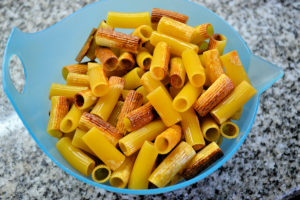



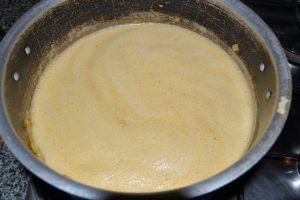

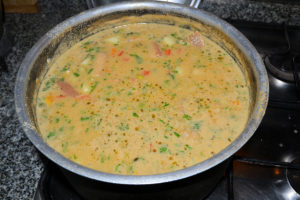
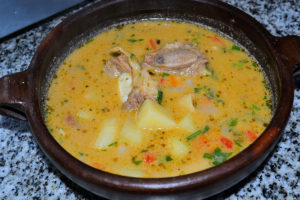
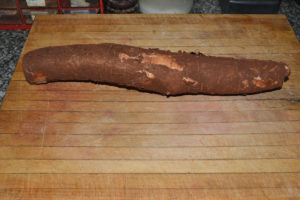
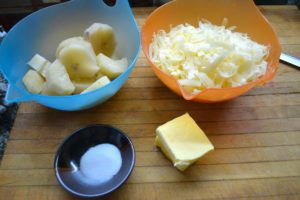
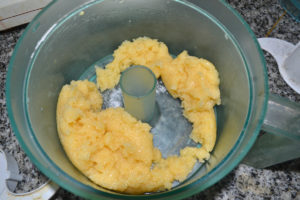




[…] Next time, and I promise, no more eight month waits, Bolivia. […]